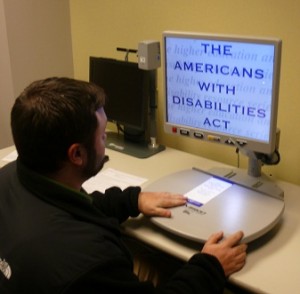
Closed Circuit Television (CCTV) magnifies a physical document and includes color contrast options for those with low vision/color blindness.
“Advancing technology is systematically changing the way universities approach education, but we must be sure that emerging technologies offer individuals with disabilities the same opportunities as other students.” (Assistant Attorney General Thomas E. Perez, United States Department of Justice)
What is Web Accessibility?
The goal of Web accessibility is to make websites usable by all people, including individuals with disabilities. Disabilities may include but are not limited to blindness/low vision, deafness/difficulty hearing, orthopedic/mobility issues, traumatic brain injuries, learning disorders, chronic illnesses, says Stacey Reycraft, Director of Student Disability Services. “According to the 2009 US General Accounting Office report on the status of students with disabilities in post secondary institutions, 11% of college students have a disability and 35.6% of those students have a disability that may directly impact their ability to access technology.” “More and more post secondary services and resources are provided in an electronic format, either through websites, course management systems, clickers, videos, etc.,” Reycraft adds. “Students do everything from applying to the University to arranging financial aid, checking grades, paying bills, taking tests, submitting homework, registering for classes and communicating with faculty. All of these services and resources have to be accessible to students with disabilities.”
Accessibility of Technology Services Policy
According to the UM Accessibility of Technology Services Policy, approximately 75% of legacy Web pages must be compliant by September 1, 2012—sooner if a specific request is made by an individual with a disability. The remainder must be made compliant by September 1, 2013. “The UM Accessibility Policy is a great first step,” says Reycraft. “The administration at UM has been very supportive of students with disabilities and making the various campus environments accessible. Now, we need to come together as a campus community and figure out how to get it done. Many universities are creating task forces to audit technology access and develop a plan of action because it’s such an enormous undertaking.”
Making Websites Accessible
“There are many techniques webmasters can use to make their sites more accessible,” states Campus Webmaster Robby Seitz. “Some examples are to use ‘alt’ attributes for images for screen readers, to write code that helps a visitor navigate without requiring a mouse, to caption video or sound clips, just to name a few.” UM departments that deploy information technology services must become familiar with these standards and make reasonable efforts to adhere to them. At the same time, department heads must make sure that information technology services deployed by their departments are accessible.
The UM Accessibility of Technology Services Policy states that official UM Web pages must pass all checks in the Wave Web Accessibility Evaluation Tool in order to be minimally compliant. Also, the Official Web Pages Policy requires that the Accessibility link be included on the primary home page of each UM unit. For more information on making Websites accessible, view Section 508 and Web Content Accessibility Guidelines. To view additional resources, refer to the UM Accessibility of Technology Services Policy.
“The law is very clear that we cannot provide accommodations in a segregated environment,” Reycraft concludes. “Therefore, students must be integrated into all campus environments, including the online environment.”
For questions and more information regarding student disabilities, contact the Office of Student Disability Services at (662) 915-7128 (office phone), (662) 915-7907 (TTY), or sds@olemiss.edu. For questions and assistance related to making websites accessible, send email to it@olemiss.edu.
Tags: Accessibility, Disability, Technology, Web Access, Web Accessibility